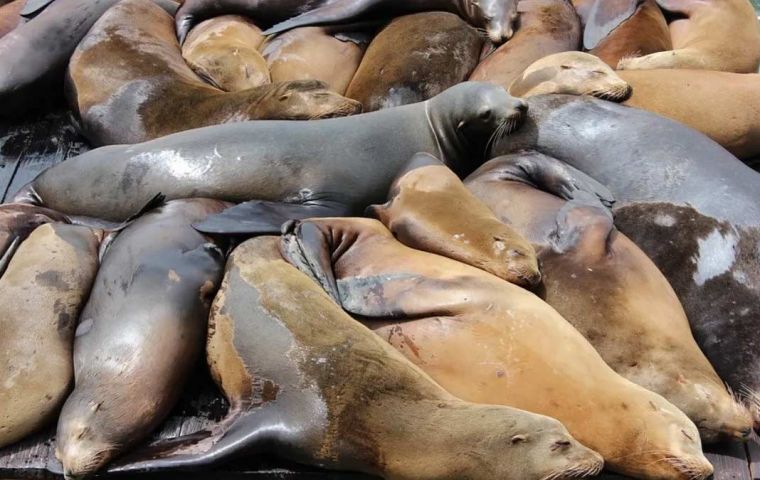MercoPress. South Atlantic News Agency
Sea lions in Necochea died of avian flu?
 Most of the sea lions found on the beaches were buried in the sand
Most of the sea lions found on the beaches were buried in the sand Argentine authorities are investigating whether the death of around 40 sea lions inside the port terminal of Necochea / Quequén was due to an outbreak of avian flu, it was reported Tuesday. A colony of about 400 sea lions is usually to be found there.
Experts from the National Service of Agrifood Health and Quality (Senasa) will be carrying out tests in the next few hours to determine the cause of death after Prefectura Naval Argentina (Coast Guard) forces closed the area. Also deployed to the area were specialists from the Marine and Coastal Research Institute of the National University of Mar del Plata and the National Council for Scientific and Technical Research (Conicet).
Last week, a sea lion was analyzed in Mar del Plata, due to a series of symptoms noticed by professionals of the local Aquarium compatible with bird flu but the results were negative. On the other hand, the death of at least seven of these mammals was positively linked to this disease in the coastal reserve of the Fuegian city of Río Grande.
All dead animals were male with a bleeding nose quite unusual when death is not due to natural causes but rather common in avian influenza, according to marine animal rescuer Carlos Leo quoted by Infobae.
“I asked for a necropsy to be performed on the bodies because it could be a case of avian influenza. There was a case of this in a sea lion settlement in Río Negro. And taking into account that in their migratory stage they can arrive in a few days to Necochea, it is possible that if there is an infected one, a contagion could be generated in other colonies,” Leo said.
The number of deaths in the last three days was fivefold the number of deaths recorded during the whole of last winter when only eight died. Last month there were also at least 10 deaths of this species. “It is very strange, we have never seen anything like it. It is more than 50 deaths against eight in the same period in 2022,″ the specialist warned.
Leo insists an influenza infection can kill within 48 hours. Avian influenza causes the animals to have a pressure problem in their brain that gives them a headache, changes their eye color to red, causes nose bleeds, and makes them tremble.
”It's like this until they are out of breath. I heard about this situation from neighbors who alerted me and when I arrived I saw some of these wolves trembling and with these characteristics. I asked for an investigation. A group of biologists from the University of Mar del Plata and Senasa are working on it,“ he added.
Regarding avian flu being transmitted from sea lions to humans, Leo pointed out that ”there are few cases of transmission to people.“
This does not mean that it cannot exist, but the possibilities are low. It may happen that if you are with your dog and it sniffs near the infected animal, maybe it licks the mucus and can bring some contagion,” he went on.
Most of the sea lions found on the beaches were buried in the sand to prevent the gases released during decomposition from remaining in the air and becoming a risk.




Top Comments
Disclaimer & comment rulesCommenting for this story is now closed.
If you have a Facebook account, become a fan and comment on our Facebook Page!